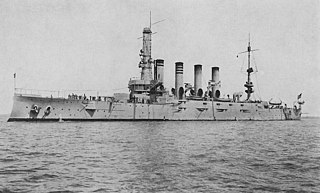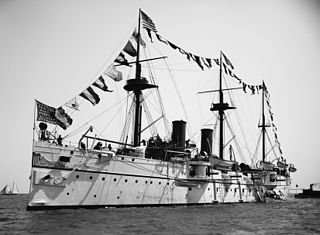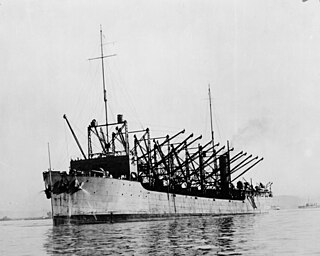
USS Langley (CV-1/AV-3) was the United States Navy's first aircraft carrier, converted in 1920 from the collier USS Jupiter, and also the US Navy's first turbo-electric-powered ship. Conversion of another collier was planned but canceled when the Washington Naval Treaty required the cancellation of the partially built Lexington-class battlecruisers Lexington and Saratoga, freeing up their hulls for conversion to the aircraft carriers Lexington and Saratoga. Langley was named after Samuel Langley, an American aviation pioneer. Following another conversion to a seaplane tender, Langley fought in World War II. On 27 February 1942, while ferrying a cargo of USAAF P-40s to Java, she was attacked by nine twin-engine Japanese bombers of the Japanese 21st and 23rd naval air flotillas and so badly damaged that she had to be scuttled by her escorts. She was also the only carrier of her class.

The first USS West Virginia (ACR-5/CA-5), also referred to as "Armored Cruiser No. 5", and later renamed Huntington, was a United States Navy Pennsylvania-class armored cruiser.

The first USS Newark (C-1) was a United States Navy protected cruiser, the eighth protected cruiser launched by the United States. In design, she succeeded the "ABC" cruisers Atlanta, Boston, and Chicago with better protection, higher speed, and a uniform 6-inch gun armament. Four additional protected cruisers were launched for the USN prior to Newark.

The seventh USS Washington (ACR-11/CA-11/IX-39), also referred to as "Armored Cruiser No. 11", and later renamed Seattle and reclassified CA-11 and IX-39, was a United States Navy Tennessee-class armored cruiser. She was laid down on 23 September 1903 at Camden, New Jersey, by the New York Shipbuilding Corporation, launched on 18 March 1905, sponsored by Miss Helen Stewart Wilson, daughter of United States Senator John L. Wilson of Washington state, and commissioned at the Philadelphia Navy Yard on 7 August 1906, Captain James D. Adams in command.

The first USS Abarenda (AC-13/AG-14) was a collier in the service of the United States Navy during World War I.

The first USS San Francisco (C-5) was a steel protected cruiser in the United States Navy. She was later named Tahoe and then Yosemite, becoming the third US Navy ship to bear the name Yosemite. She generally resembled her predecessor Newark, with a main armament of twelve 6-inch guns.

The collier USS Proteus (AC-9) was laid down on 31 October 1911, by the Newport News Shipbuilding and Dry Dock Company, and launched on 14 September 1912. She was the lead ship of her class of four colliers. She was commissioned on 9 July 1913, to the United States Navy.

USS Alcyone (AKA-7) was an Arcturus-class attack cargo ship named after Alcyone, the brightest star in the star cluster Pleiades. She served as a commissioned ship for five years and one month.

USS Reina Mercedes (IX-25) was an unprotected cruiser of the Spanish Navy which was captured in Cuba in 1898 by the U.S. Navy during the Spanish–American War. She was refurbished and used by the U.S. Navy as a non-self-propelled receiving ship at Newport, Rhode Island, and subsequently as a detention vessel and barracks ship for the United States Naval Academy in Annapolis, Maryland, until 1957.

USS Ajax (AC-14/AG-15) was a collier in the United States Navy. Originally she retained her previous name of Scindia, and was renamed for the mythical Ajax in 1901. In 1921, she became a receiving ship and was redesignated AC-14. She was reclassified as a seaplane tender and given the hull designator AG-15 in 1924.

USS Leonidas (AD-7) was a destroyer tender, the lone ship in her class, named for Leonidas I, and the second United States naval vessel to bear the name.

USS Grebe (AM-43) was a Lapwing-class minesweeper in the United States Navy.

The second USS Mars (AC-6) was a collier of the United States Navy. The ship was laid down by the Maryland Steel Co., Sparrows Point, Maryland on 5 October 1908, launched on 10 April 1909, sponsored by Miss Juliana Keyser, and commissioned at Norfolk on 26 August 1909. She was the sister of the USS Hector (AC-7).

The third USS Neptune (AC–8), a collier of the U.S. Navy, was laid down by the Maryland Steel Co., Sparrows Point, Md. 23 March 1910; launched 21 January 1911; and placed in service with a merchant crew at Norfolk Navy Yard 20 September 1911.

USS Jason (AC-12/AV-2) was a collier in service with the United States Navy from 1913 to 1932. She was then sold into commercial service and served as SS Jason until she was scrapped in 1948.

USS Brutus, formerly the steamer Peter Jebsen, was a collier in the United States Navy. She was built in 1894 at South Shields-on-Tyne, England, by John Readhead & Sons and was acquired by the U.S. Navy early in 1898 from L. F. Chapman & Company. She was renamed Brutus and commissioned at the Mare Island Navy Yard on 27 May 1898, with Lieutenant Vincendon L. Cottman, commanding officer and Lieutenant Randolph H. Miner, executive officer.

USS Caesar (AC-16) was a collier that was built in England in 1896 and scrapped in Japan in 1935. She was launched as Kingtor for a British shipping company, served in the United States Navy as Caesar from 1898 to 1923, and then was sold to a Canadian shipping company who renamed her Mogul.

USS Lebanon (AG-2) was a 3,285-long-ton (3,338-metric-ton) collier, which the United States Navy acquired in 1898 from the Philadelphia and Reading RR. Company to provide coal for Navy warships during the Spanish–American War. When the need for her coal was no longer a necessity, Lebanon was assigned various duty such as transporting stores as well as target repair and towing operations.
USS Don Juan de Austria was a U.S. Navy gunboat. Formerly a Spanish Navy Velasco class unprotected cruiser, she was captured in 1898 during the Spanish–American War and commissioned into the U.S. Navy.

USS Nero (AC–17), a steel steam collier, was launched in 1894 as the steamer Whitgift by J.L. Thompson and Sons, Sunderland, England. The vessel was purchased on 30 June 1898 from McCondray and Co. at San Francisco and commissioned on 8 June 1898.



















